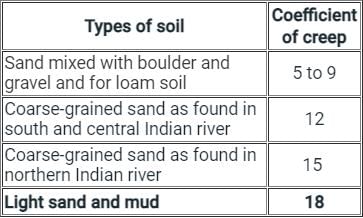Test: Bligh's Creep Theory - Civil Engineering (CE) MCQ
10 Questions MCQ Test Irrigation Engineering - Test: Bligh's Creep Theory
What is the value of Bligh’s coefficient for coarse-grained soil?
The Bligh’s creep coefficient for light sand and mud is:
For sand mixed with boulder and gravel and for loam soil, the safe hydraulic gradient should be ___________
Which of the following is not a limitation of creep theory?
If the value of Bligh’s coefficient for a particular soil is equal to 12 then, what is the safe hydraulic gradient for that soil?
Consider the following statements about Bligh’s Creep Theory.
i. Creep length is the length of path traversed by percolating water
ii. To increase the path of percolation vertical cut-off or sheet piles can be provided
iii. Loss of head per unit creep length is hydraulic gradient
iv. Bligh gave no criteria for the safety of weir against undermining
Which of the following statements are correct?
As per Bligh’s theory, thickness to be provided by taking a factor of safety equal to _______
According to Bligh, a vertical cut-off at U/s end of the floor is less useful than the one at the D/s end of the floor.
|
7 videos|49 docs|31 tests
|

























